winter tires MERCEDES-BENZ GL 2016 Owners Manual
[x] Cancel search | Manufacturer: MERCEDES-BENZ, Model Year: 2016, Model line: GL, Model: MERCEDES-BENZ GL 2016Pages: 462, PDF Size: 12.66 MB
Page 25 of 462
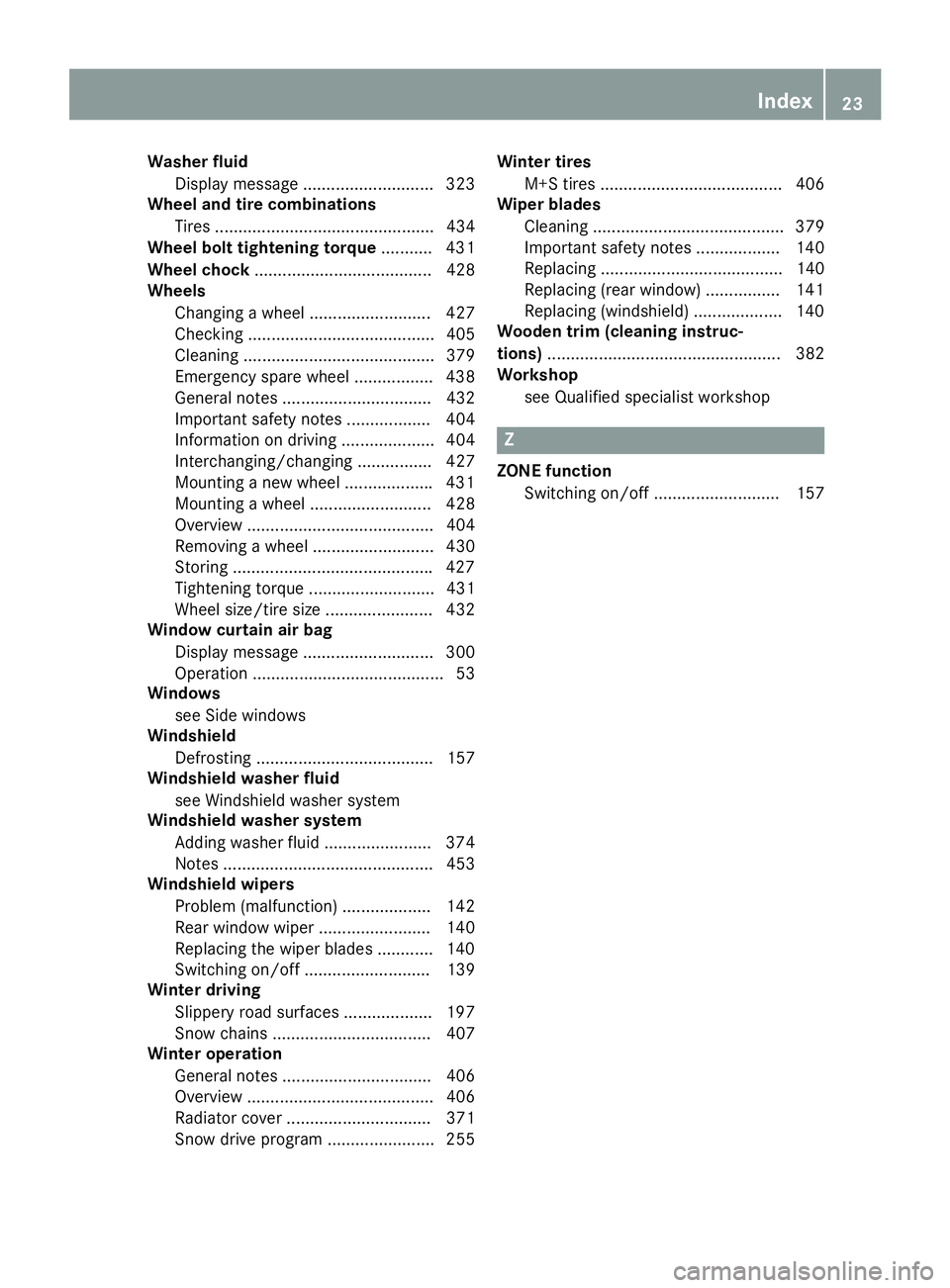
Washer fluid
Display message ............................ 323
Wheel and tire combinations
Tires ............................................... 434
Wheel bolt tightening torque ........... 431
Wheel chock ...................................... 428
Wheels
Changing a wheel .......................... 427
Checking ........................................ 405
Cleaning ......................................... 379
Emergency spare wheel ................. 438
General notes ................................ 432
Important safety notes .................. 404
Information on driving .................... 404
Interchanging/changing ................ 427
Mounting a new wheel .................. .4 31
Mounting a wheel .......................... 428
Overview ........................................ 404
Removing a wheel .......................... 430
Storing .......................................... .4 27
Tightening torque ........................... 431
Wheel size/tire size ....................... 432
Window curtain air bag
Display message ............................ 300
Operation ......................................... 53
Windows
see Side windows
Windshield
Defrosting ...................................... 157
Windshield washer fluid
see Windshield washer system
Windshield washer system
Adding washer fluid ....................... 374
Notes ............................................. 453
Windshield wipers
Problem (malfunction) ................... 142
Rear window wiper ........................ 140
Replacing the wiper blades ............ 140
Switching on/off ........................... 139
Winter driving
Slippery road surfaces ................... 197
Snow chains .................................. 407
Winter operation
General notes ................................ 406
Overview ........................................ 406
Radiator cover ............................... 371
Snow drive program ....................... 255 Winter tires
M+S tires ....................................... 406
Wiper blades
Cleaning .............. ........................... 379
Important safe ty
notes .................. 140
Replacing ....................................... 140
Replacing (rear window) ................ 141
Replacing (windshield) ................... 140
Wooden trim (cleaning instruc-
tions) .................................................. 382
Workshop
see Qualified specialist workshop
Z ZONE function
Switching on/off ........................... 157 Index 23
Page 200 of 462
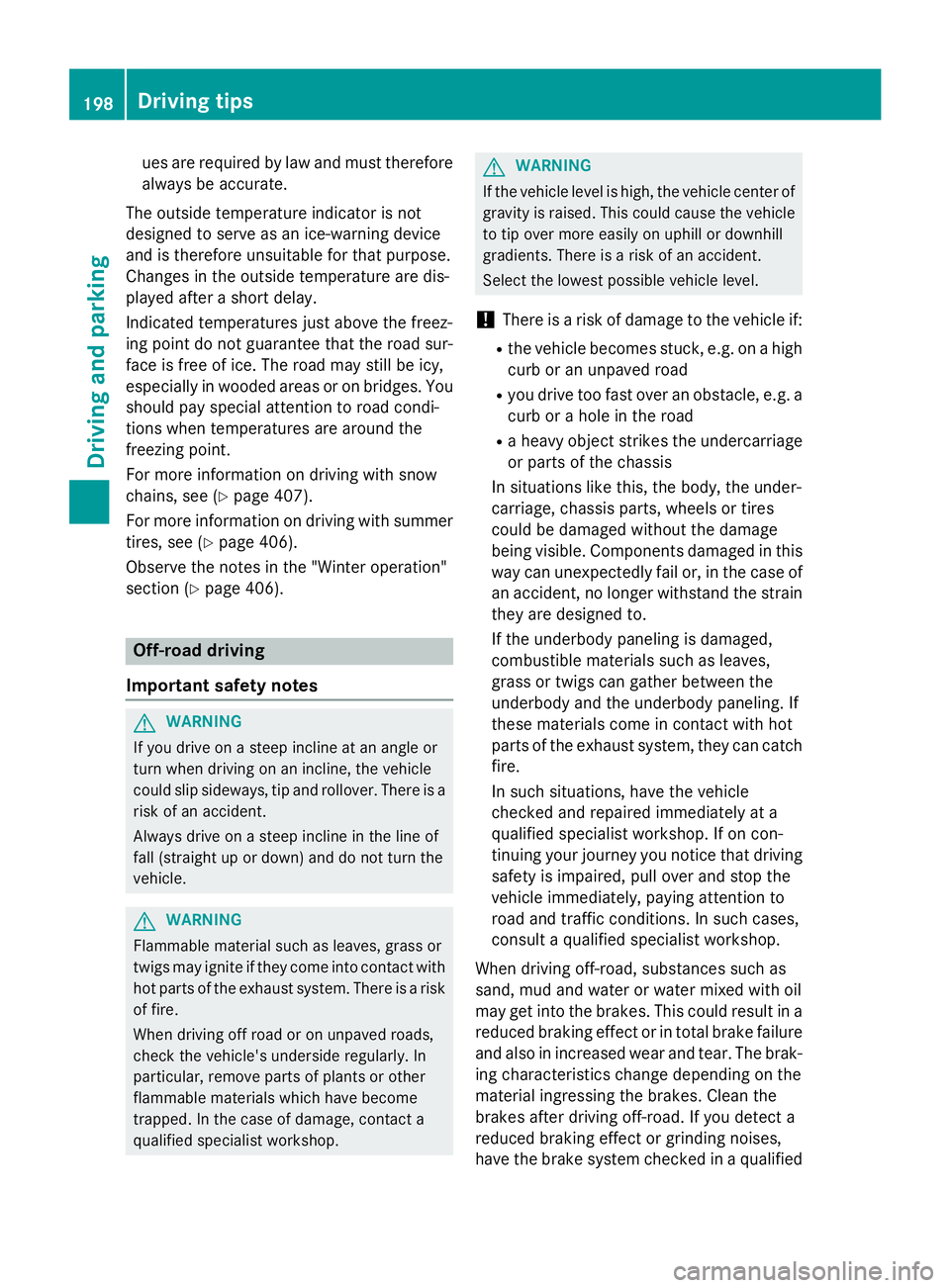
ues are required by law and must therefore
always be accurate.
The out side temperature indicator is not
designed to ser ve as an ice-warning device
and is therefore unsuitable for that purpose.
Changes in the outside temperature are dis-
played after a short delay.
Indic ated temperatures just above the freez-
ing poin t do not guarantee that the road sur-
face is free of ice. The road may still be icy,
especial ly in wooded areas or on bridges. You
should pay special attention to road condi-
tions when temperatures are around the
freezing poin t.
For more information on driving wit h snow
chains, see ( Y
page 407).
For more information on driving wit h summer
tires, see ( Y
page 406).
Observe the notes in the "Winter operation"
section ( Y
page 406).
Off-road driving
Important safety notes
G WARNIN G
If you driv e on a steep inclin e at an angle or
tur n when driving on an incline, th e vehicl e
could slip sideways, ti p and rollover. Ther e is a
ris k of an accident.
Always driv e on a steep inclin e in th e lin e of
fall (straight up or down ) and do no t tur n th e
vehicle.
G WARNIN G
Flammable materia l suc h as leaves, gras s or
twigs may ignit e if they come int o contact wit h
hot part s of th e exhaust system. Ther e is a ris k
of fire.
When driving off road or on unpaved roads,
check th e vehicle's underside regularly. In
particular, remove part s of plants or other
flammable materials whic h have become
trapped . In th e cas e of damage, contact a
qualified specialist workshop. G WARNIN G
If th e vehicl e leve l is high , th e vehicl e cente r of
gravity is raised. This could caus e th e vehicl e
to tip ove r mor e easil y on uphill or downhill
gradients . Ther e is a ris k of an accident.
Selec t th e lowes t possible vehicl e level.
! There is a risk of damage to the vehicle if: R
the vehicle becomes stuck, e.g. on a high
curb or an unpaved road R
you driv e too fast over an obstacle, e.g. a
curb or a hole in the road R
a heavy object strikes the undercarriage
or parts of the chassis
In situations lik e this, the body, the under-
carriage, chassis parts, wheels or tires
could be damaged without the damage
being vis ible. Components damaged in th is
way can unexpectedly fail or, in the case of
an acc iden t, no longer withstand the strain
they are designed to.
If the underbody paneling is damaged,
combusti ble materials such as leaves,
grass or twigs can gather between the
underbody and the underbody paneling. If
these materials come in contact wit h hot
parts of the exhaust system, they can catch
fire.
In such situations, have the vehicle
checked and repaired immediately at a
qualif ied spec ialist worksho p. If on con-
tinuing your jo urney you notice that driv ing
safety is impaired, pull over and st op the
v eh
icle immediately, paying attention to
road and traff ic cond it ions. In such cases,
consult a qualif ied spec ialist worksho p.
When driv ing off-road, substances such as
san d, mud and water or water mixed wit h oil
may get into the brakes. This could result in a
reduced braking effect or in total brake failure
and also in increased wear and tear. The brak-
ing characteristics change depe nding on the
material ingressing the brakes. Clean the
brakes after driv ing off-road. If you detect a
reduced braking effect or grinding noises,
have the brake system checked in a qualif ied198
Driving tips
Driving and parking
Page 259 of 462
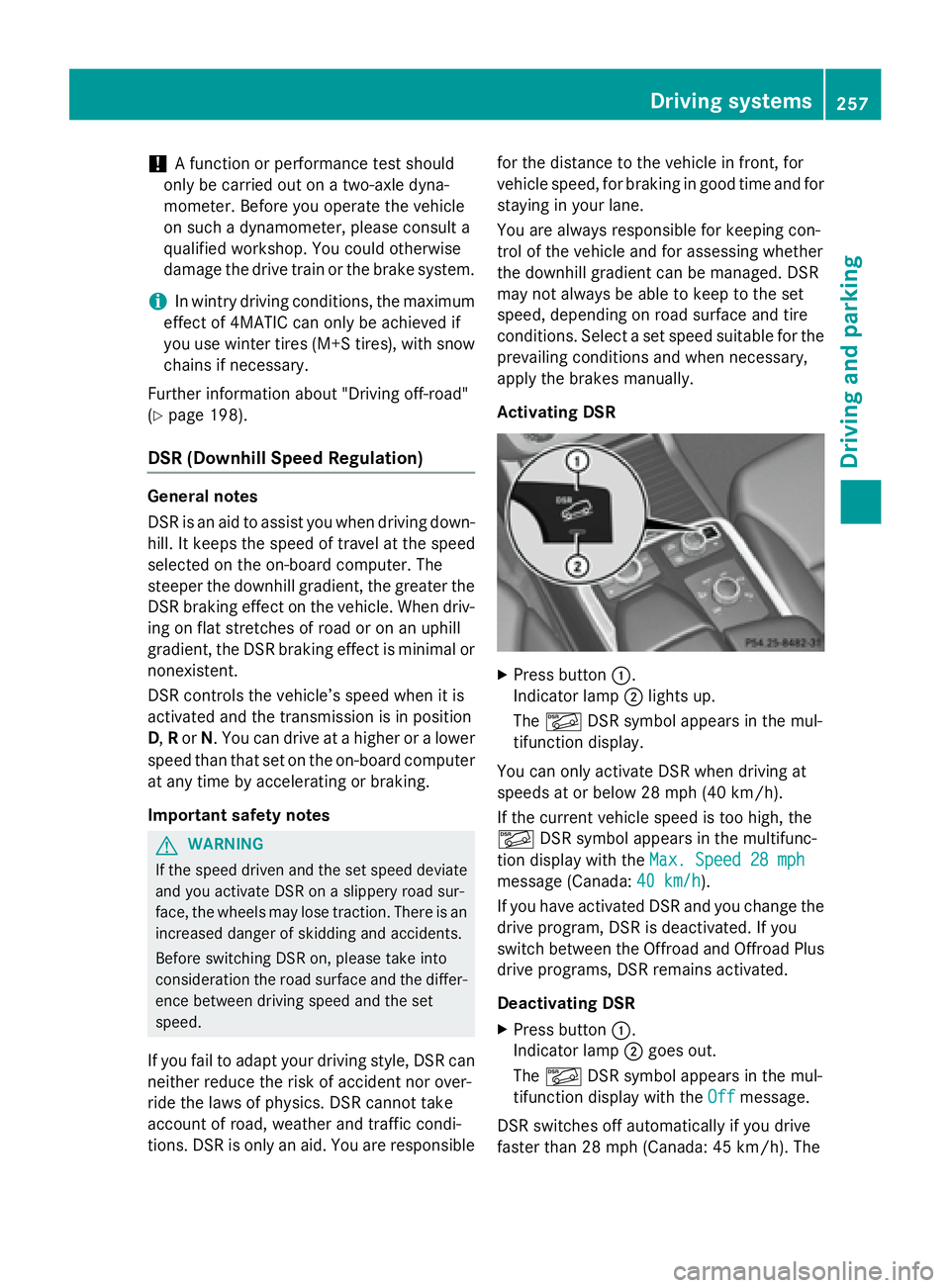
! A function or performance test should
only be carried out on a two-axle dyna-
mometer. Before you operate the vehicle
on such a dynamometer, please consult a
qualified workshop. You could otherwise
damage the drive train or the brake system.
i In wintry driving conditions, the maximum
effect of 4MATIC can only be achieved if
you use winter tires (M +S tires), with snow
chains if necessary.
Further information about "Driving off-road"
( Y
page 198).
DSR (Downhill Speed Regulation) General notes
DSR is an aid to assist you when driving down-
hill. It keeps the speed of travel at the speed
selected on the on-board computer. The
steeper the downhill gradient, the greater the
DSR braking effect on the vehicle. When driv-
ing on flat stretches of road or on an uphill
gradient, the DSR braking effect is minimal or
nonexistent.
DSR controls the vehicle’s speed when it is
activated and the transmission is in position
D , R or N . You can drive at a higher or a lower
speed than that set on the on-board computer
at any time by accelerating or braking.
Important safety notes
G WARNING
If the speed driven and the set speed deviate
and you activate DSR on a slippery road sur-
face, the wheels may lose traction. There is an
increased danger of skidding and accidents.
Before switching DSR on, please take into
consideration the road surface and the differ-
ence between driving speed and the set
speed.
If you fail to adapt your driving style, DSR can
neither reduce the risk of accident nor over-
ride the laws of physics. DSR cannot take
account of road, weather and traffic condi-
tions. DSR is only an aid. You are responsible for the distance to the vehicle in front, for
vehicle speed, for braking in good time and for
staying in your lane.
You are always responsible for keeping con-
trol of the vehicle and for assessing whether
the downhill gradient can be managed. DSR
may not always be able to keep to the set
speed, depending on road surface and tire
conditions. Select a set speed suitable for the
prevailing conditions and when necessary,
apply the brakes manually.
Activating DSR
X
Press button �C .
Indicator lamp �D lights up.
The �
Page 379 of 462
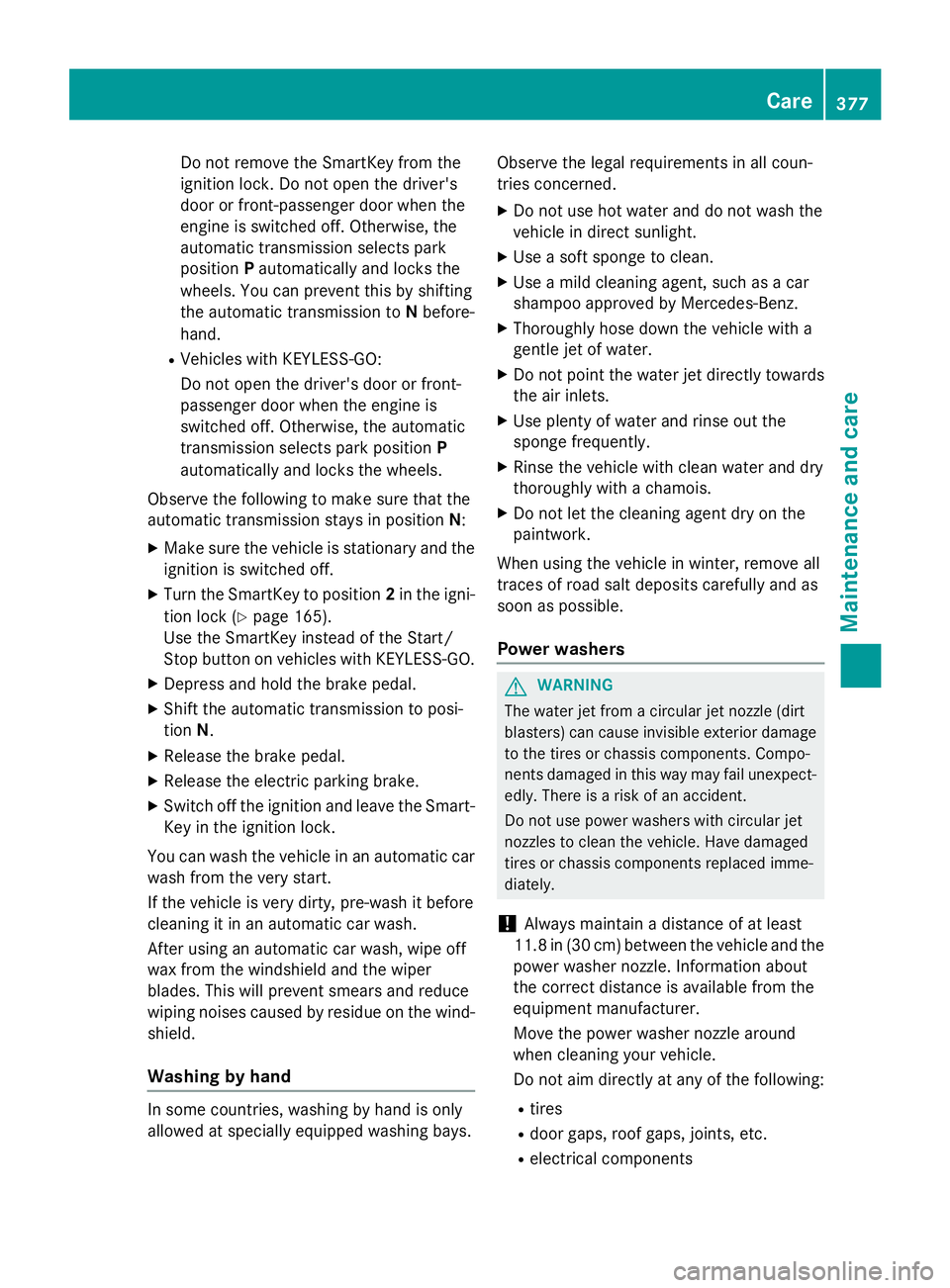
Do not remove the SmartKey from the
ignition lock. Do not open the driver's
door or front-passenger door when the
engine is switched off. Otherwise, the
automatic transmission selects park
position P automatically and locks the
wheels. You can prevent this by shifting
the automatic transmission to N before-
hand. R
Vehicles with KEYLESS-GO:
Do not open the driver's door or front-
passenger door when the engine is
switched off. Otherwise, the automatic
transmission selects park position P
automatically and locks the wheels.
Observe the following to make sure that the
automatic transmission stays in position N :X
Make sure the vehicle is stationary and the
ignition is switched off. X
Turn the SmartKey to position 2 in the igni-
tion lock ( Y
page 165).
Use the SmartKey instead of the Start/
Stop button on vehicles with KEYLESS-GO. X
Depress and hold the brake pedal. X
Shift the automatic transmission to posi-
tion N .X
Release the brake pedal. X
Release the electric parking brake. X
Switch off the ignition and leave the Smart-
Key in the ignition lock.
You can wash the vehicle in an automatic car
wash from the very start.
If the vehicle is very dirty, pre-wash it before
cl e
aning it in an automatic car wash.
After using an automatic car wash, wipe off
wax from the windshield and the wiper
blades. This will prevent smears and reduce
wiping noises caused by residue on the wind-
shield.
Washing by hand
In some countries, washing by hand is only
allowed at specially equipped washing bays. Observe the legal requirements in all coun-
tries concerned. X
Do not use hot water and do not wash the
vehicle in direct sunlight. X
Use a soft sponge to clean. X
Use a mild cleaning agent, such as a car
shampoo approved by Mercedes-Benz. X
Thoroughly hose down the vehicle with a
gentle jet of water. X
Do not point the water jet directly towards
the air inlets. X
Use plenty of water and rinse out the
sponge frequently. X
Rinse the vehicle with clean water and dry
thoroughly with a chamois. X
Do not let the cleaning agent dry on the
paintwork.
When using the vehicle in winter, remove all
traces of road salt deposits carefully and as
soon as possible.
Power washers
G WARNING
The water jet from a circular jet nozzle (dirt
blasters) can cause invisible exterior damage
to the tires or chassis components. Compo-
nents damaged in this way may fail unexpect-
edly. There is a risk of an accident.
Do not use power washers with circular jet
nozzles to clean the vehicle. Have damaged
tires or chassis components replaced imme-
diately.
! Always maintain a distance of at least
11.8 in (30 cm) between the vehicle and the
power washer nozzle. Information about
the correct distance is available from the
equipment manufacturer.
Move the power washer nozzle around
when cleaning your vehicle.
Do not aim directly at any of the following: R
tires R
door gaps, roof gaps, joints, etc. R
electrical components Care 377
Maintenance and care Z
Page 390 of 462
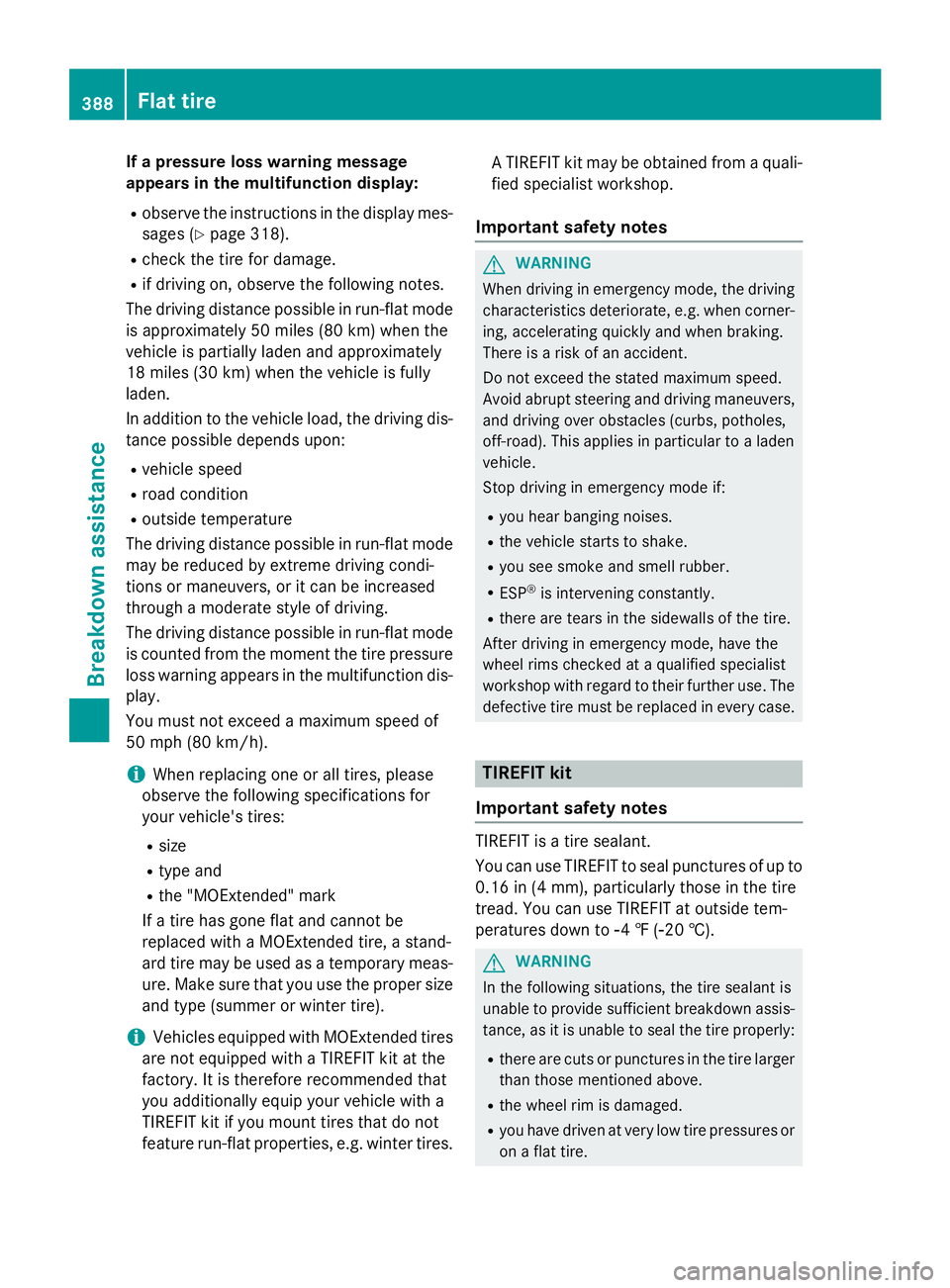
If a pressure loss warning message
appears in the multifunction display: R
observe the instructions in the display mes-
sages ( Y
page 318).R
check the tire for damage. R
if driving on, observe the following notes.
The driving distance possible in run-flat mode
is approximately 50 miles (80 km) when the
vehicle is partially laden and approximately
18 miles (30 km ) when the vehicle is fully
laden.
In addition to the vehicle load, the driving dis-
tance possible depends upon: R
vehicle speed R
road condition R
outside temperature
The driving distance possible in run-flat mode
may be reduced by extreme driving condi-
tions or maneuvers, or it can be increased
through a moderate style of driving.
The driving distance possible in run-flat mode
is counted from the moment the tire pressure
loss warning appears in the multifunction dis-
play.
You must not exceed a maximum speed of
50 mph (80 km/h).
i When replacing one or all tires, please
observe the following specifications for
your vehicle's tires: R
size R
type and R
the "MOExtended" mark
If a tire has gone flat and cannot be
replaced with a MOExtended tire, a stand-
ard tire may be used as a temporary meas-
ure. Make sure that you use the proper size
and type (summer or winter tire).
i Vehicles equipped with MOExtended tires
are not equipped with a TIREFIT kit at the
factory. It is therefore recommend ed that
you additionally equip your vehicle with a
TIREFIT kit if you mount tires that do not
feature run-flat properties, e.g. winter tires. A TIREFIT kit may be obtained from a quali-
fied specialist workshop.
Important safety notes
G WARNING
When driving in emergency mode, the driving
characteristics deteriorate, e.g. when corner-
ing, accelerating quickly and when braking.
There is a risk of an accident.
Do not exceed the stated maximum speed.
Avoid abrupt steering and driving maneuvers,
and driving over obstacles (curbs, potholes,
off-road). This applies in particular to a laden
vehicle.
Stop driving in emergency mode if: R
you hear banging noises. R
the vehicle starts to shake. R
you see smoke and smell rubber. R
ESP ®
is intervening constantly. R
there are tears in the sidewalls of the tire.
After driving in emergency mode, have the
wheel rims checked at a qualified specialist
workshop with regard to their further use. The
defective tire must be replaced in every case.
TIREFIT kit
Important safety notes
TIREFIT is a tire sealant.
You can use TIREFIT to seal punctures of up to
0.16 in (4 mm), particularly those in the tire
tread. You can use TIREFIT at outside tem-
peratures down to �
Page 405 of 462
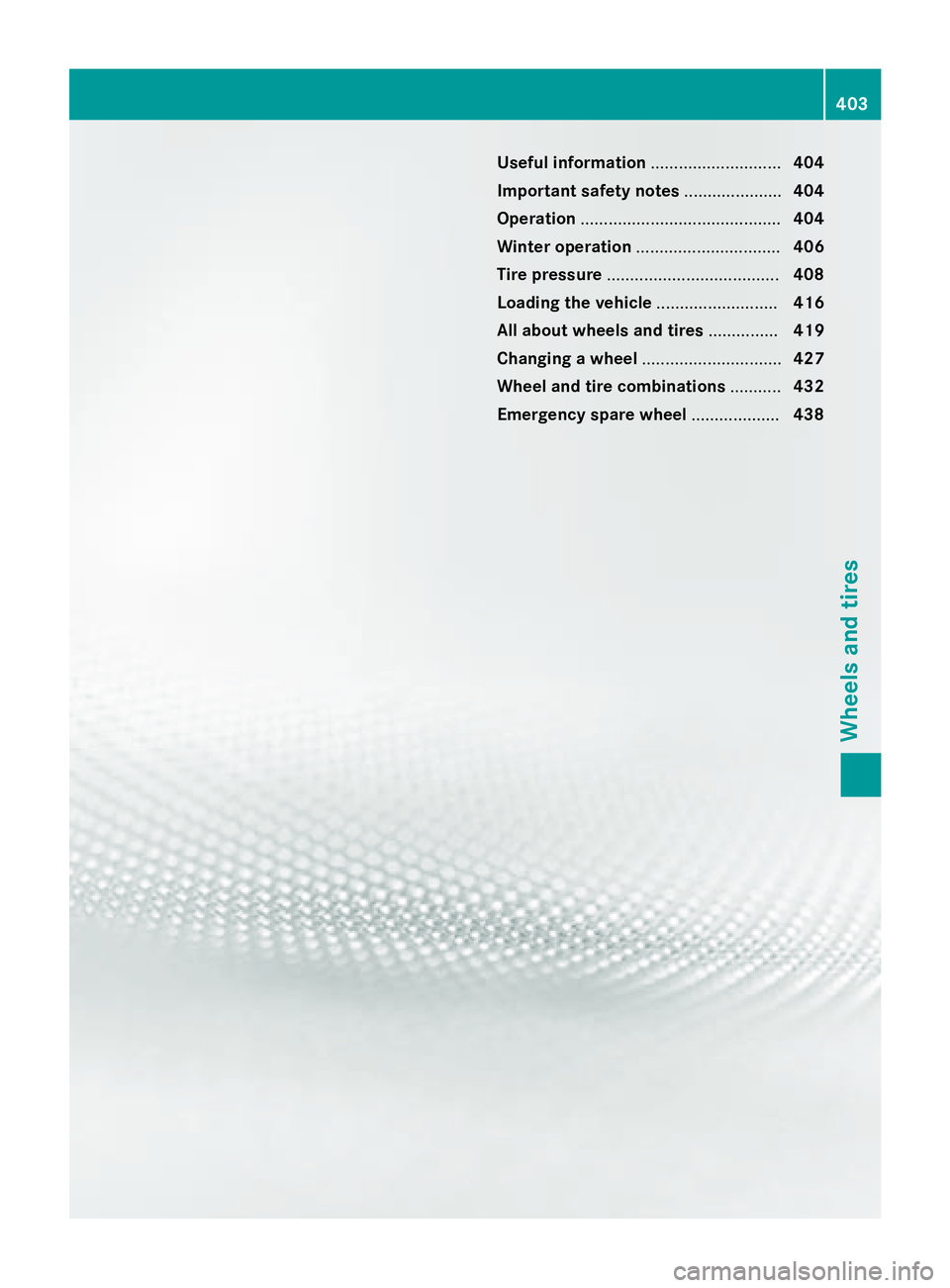
Useful information ............................ 404
Important safety notes ..................... 404
Operation ........................................... 404
Winter operation ............................... 406
Tire pressure ..................................... 408
Loading the vehicle .......................... 416
All about wheels and tires ............... 419
Changing a wheel .............................. 427
Wheel and tire combinations ........... 432
Emergency spare wheel ................... 438 403
Wheels and tires
Page 409 of 462
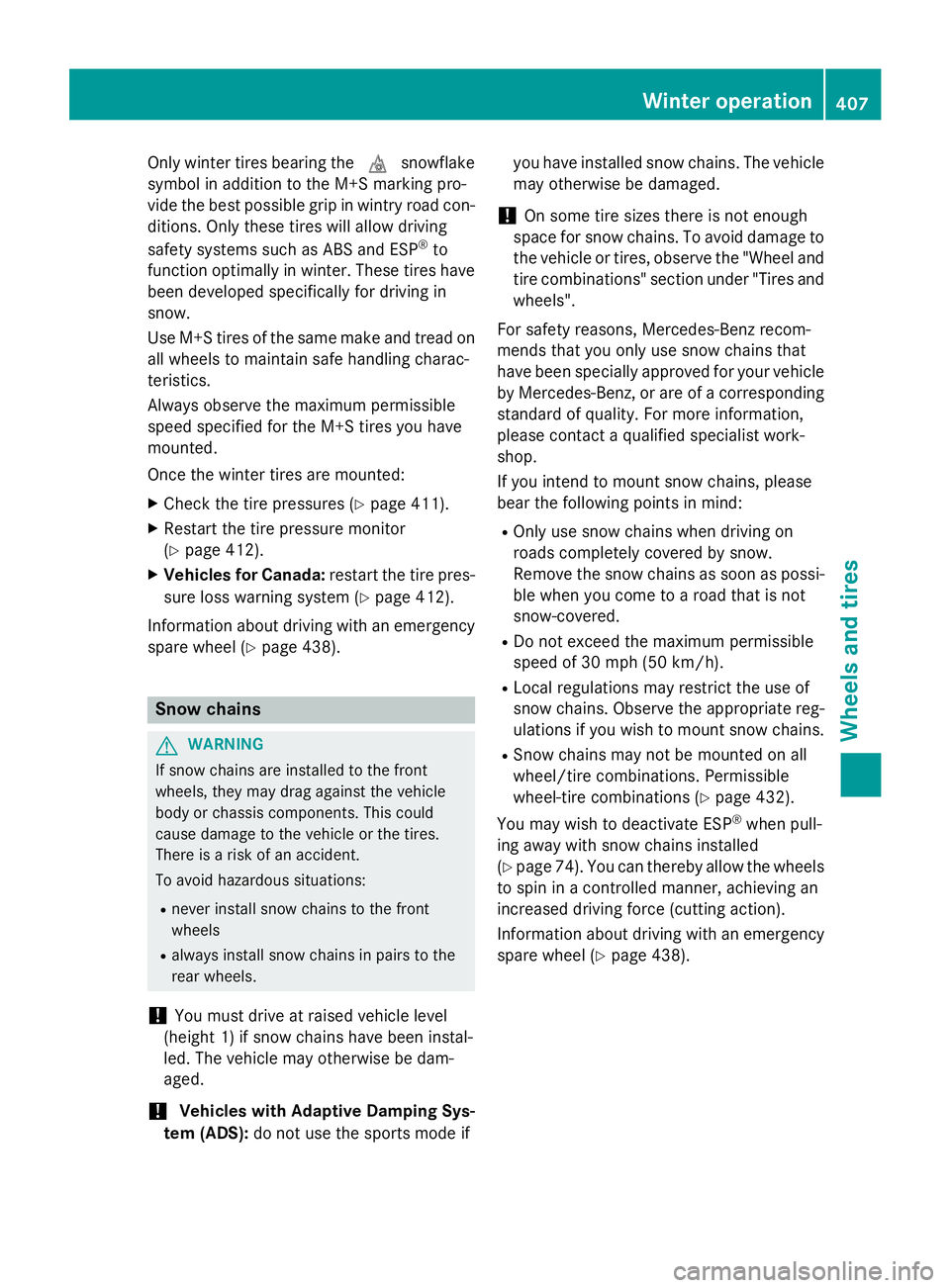
Only winter tires bearing the �M snowflake
symbol in addition to the M+S marking pro-
vide the best possible grip in wintry road con-
ditions. Only these tires will allow driving
safety systems such as ABS and ESP ®
to
function optimally in winter. These tires have
been developed specifically for driving in
snow.
Use M+S tires of the same make and tread on
all wheels to maintain safe handling charac-
teristics.
Always observe the maximum permissible
speed specified for the M+S tires you have
mounted.
Once the winter tires are mounted: X
Check the tire pressures ( Y
page 411).X
Restart the tire pressure monitor
( Y
page 412). X
Vehicles for Canada: restart the tire pres-
sure loss warning system ( Y
page 412).
Information about driving with an emergency
spare wheel ( Y
page 438).
Snow chains
G WARNING
If snow chains are installed to the front
wheels, they may drag against the vehicle
body or chassis components. This could
cause damage to the vehicle or the tires.
There is a risk of an accident.
To avoid hazardous situations: R
never install snow chains to the front
wheels R
always install snow chains in pairs to the
rear wheels.
! You must drive at raised vehicle level
(height 1) if snow chains have been instal-
led. The vehicle may otherwise be dam-
aged.
! Vehicles with Adaptive Damping Sys-
tem (ADS): do not use the sports mode if you have installed snow chains. The vehicle
may otherwise be damaged.
! On some tire sizes there is not enough
space for snow chains. To avoid damage to
the vehicle or tires, observe the "Wheel and
tire combinations" section under "Tires and
wheels".
For safety reasons, Mercedes-Benz recom-
mends that you only use snow chains that
have been specially approved for your vehicle
by Mercedes-Benz, or are of a corresponding
standard of quality. For more information,
please contact a qualified specialist work-
shop.
If you intend to mount snow chains, please
bear the following points in mind: R
Only use snow chains when driving on
roads completely covered by snow.
Remove the snow chains as soon as possi-
ble when you come to a road that is not
snow-covered. R
Do not exceed the maximum permissible
speed of 30 mph (50 km/h). R
Local regulations may restrict the use of
snow chains. Observe the appropriate reg-
ulations if you wish to mount snow chains. R
Snow chains may not be mounted on all
wheel/tire combinations. Permissible
wheel-tire combinations ( Y
page 432).
You may wish to deactivate ESP ®
when pull-
ing away with snow chains installed
( Y
page 74). You can thereby allow the wheels
to spin in a controlled manner, achieving an
increased driving force (cutting action).
Information about driving with an emergency
spare wheel ( Y
page 438).Winter operation 407
Wheels and tires Z
Page 425 of 462
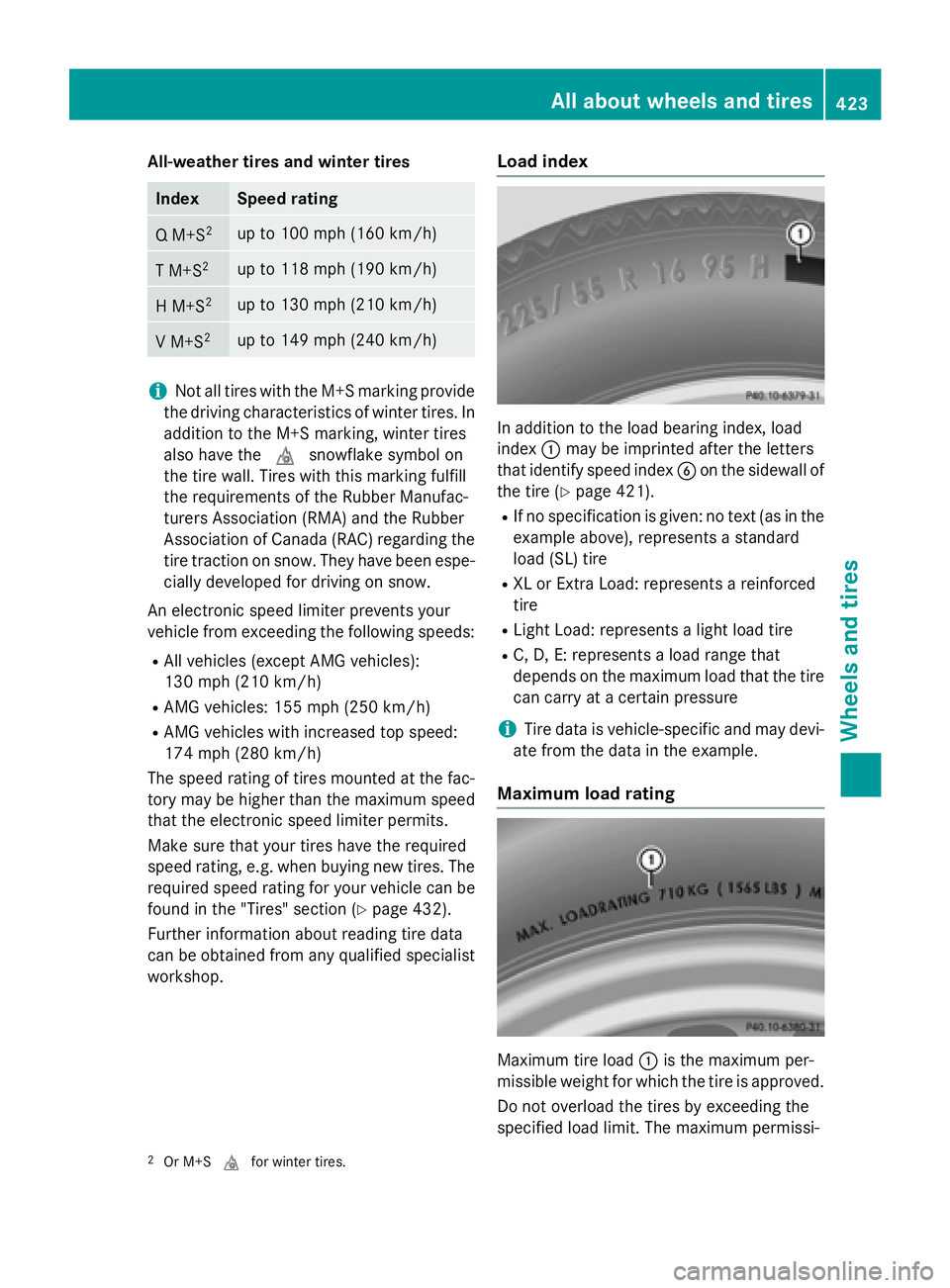
All-weather tires and winter tires
Index Speed ra ting
Q M+S 2
up to 100 mph (160 km/h)
T M+S 2
up to 118 mph (190 km/h)
H M+S 2
up to 130 mph (210 km/h)
V M+S 2
up to 149 mph (240 km/h)
i Not all tires with the M+S marking provide
the driv ing characteristics of winter tires. In
addit ion to the M+S marking, winter tires
also have the �M snowflake symbol on
the tire wall. Tires wit h this marking fulfill
the requirements of the Rubber Manufac-
turers Association (RMA) and the Rubber
Association of Canada (RAC) regarding the
tire traction on snow. They have been espe-
cial ly developed for driving on snow.
An electron ic speed limiter prevents your
veh icle from exceeding the fol lowin g speeds:R
All veh icle s (except AMG vehicles):
130 mph (210 km/h) R
AMG veh icle s: 155 mph (250 km/h)R
AMG veh icle s wit h increased top speed:
174 mph (280 km/h)
The speed rating of tires mounted at the fac-
tory may be higher than the maximum speed
that the electronic speed limiter permits.
Make sure that your tires have the required
speed rating, e.g. when buying new tires. The
required speed rating for your vehicle can be
found in the "Tires" section ( Y
page 432).
Further information about reading tire data
can be obtained from any qualified specialist
worksho p. Load index
In addition to the load bearing index, load
index �C may be imprinted after the letters
that identify speed index �
Page 435 of 462
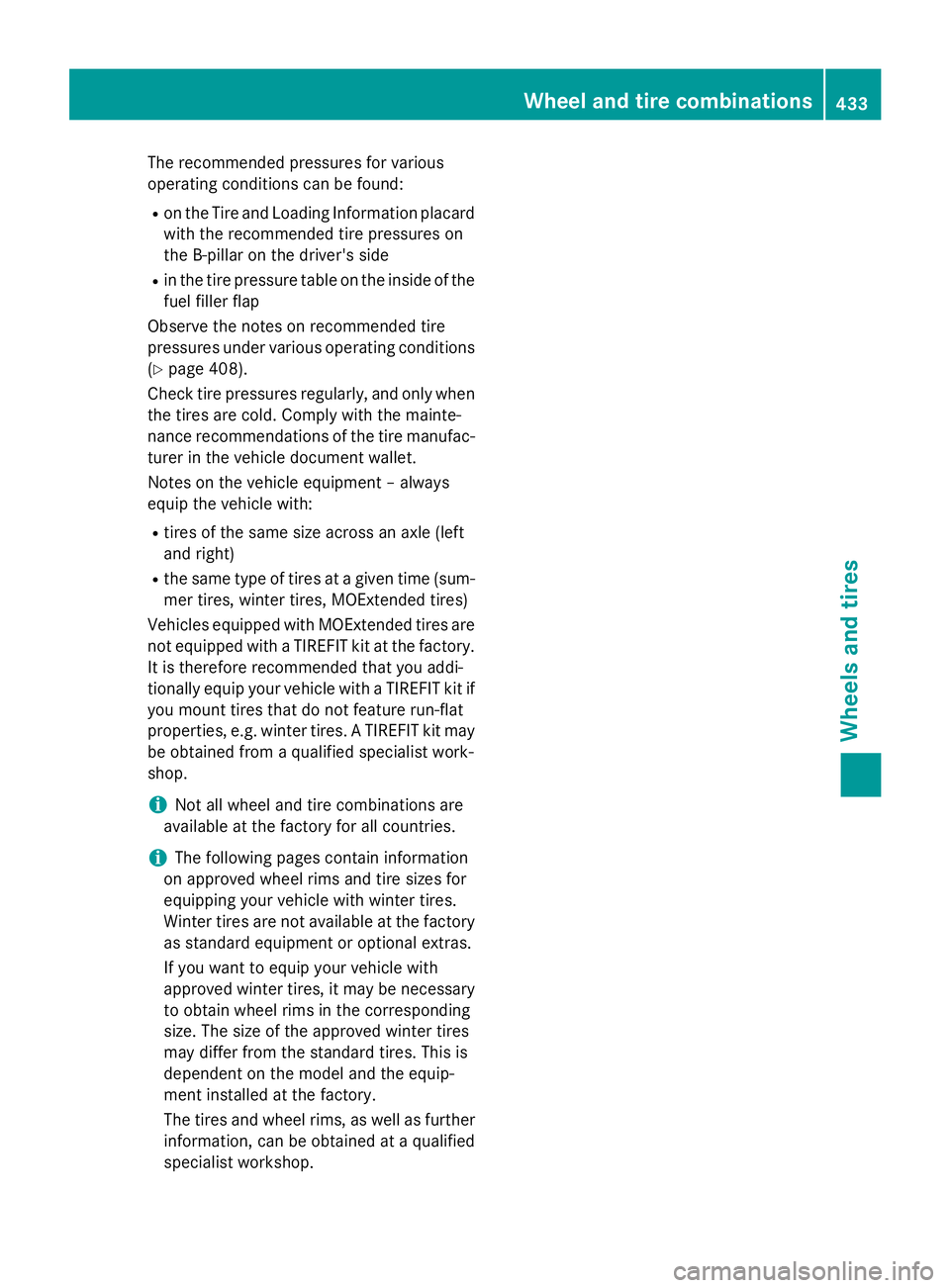
The recommended pressures for various
operating conditions can be found: R
on the Tire and Loading Information placard
with the recommended tire pressures on
the B-pillar on the driver's side R
in the tire pressure table on the inside of the
fuel filler flap
Observe the notes on recommended tire
pressures under various operating conditions
( Y
page 408).
Check tire pressures regularly, and only when
the tires are cold. Comply with the mainte-
nance recommendations of the tire manufac-
turer in the vehicle document wallet.
Notes on the vehicle equipment – always
equip the vehicle with: R
tires of the same size across an axle (left
and right) R
the same type of tires at a given time (sum-
mer tires, winter tires, MOExtended tires)
Vehicles equipped with MOExtended tires are
not equipped with a TIREFIT kit at the factory.
It is therefore recommended that you addi-
tionally equip your vehicle with a TIREFIT kit if
you mount tires that do not feature run-flat
properties, e.g. winter tires. A TIREFIT kit may
be obtained from a qualified specialist work-
shop.
i Not all wheel and tire combinations are
available at the factory for all countries.
i The following pages contain information
on approved wheel rims and tire sizes for
equipping your vehicle with winter tires.
Winter tires are not available at the factory
as standard equipment or optional extras.
If you want to equip your vehicle with
approved winter tires, it may be necessary
to obtain wheel rims in the corresponding
size. The size of the approved winter tires
may differ from the standard tires. This is
dependent on the model and the equip-
ment installed at the factory.
The tires and wheel rims, as well as further
information, can be obtained at a qualified
specialist workshop. Wheel and tire combinations 433
Wheels and tires Z
Page 436 of 462
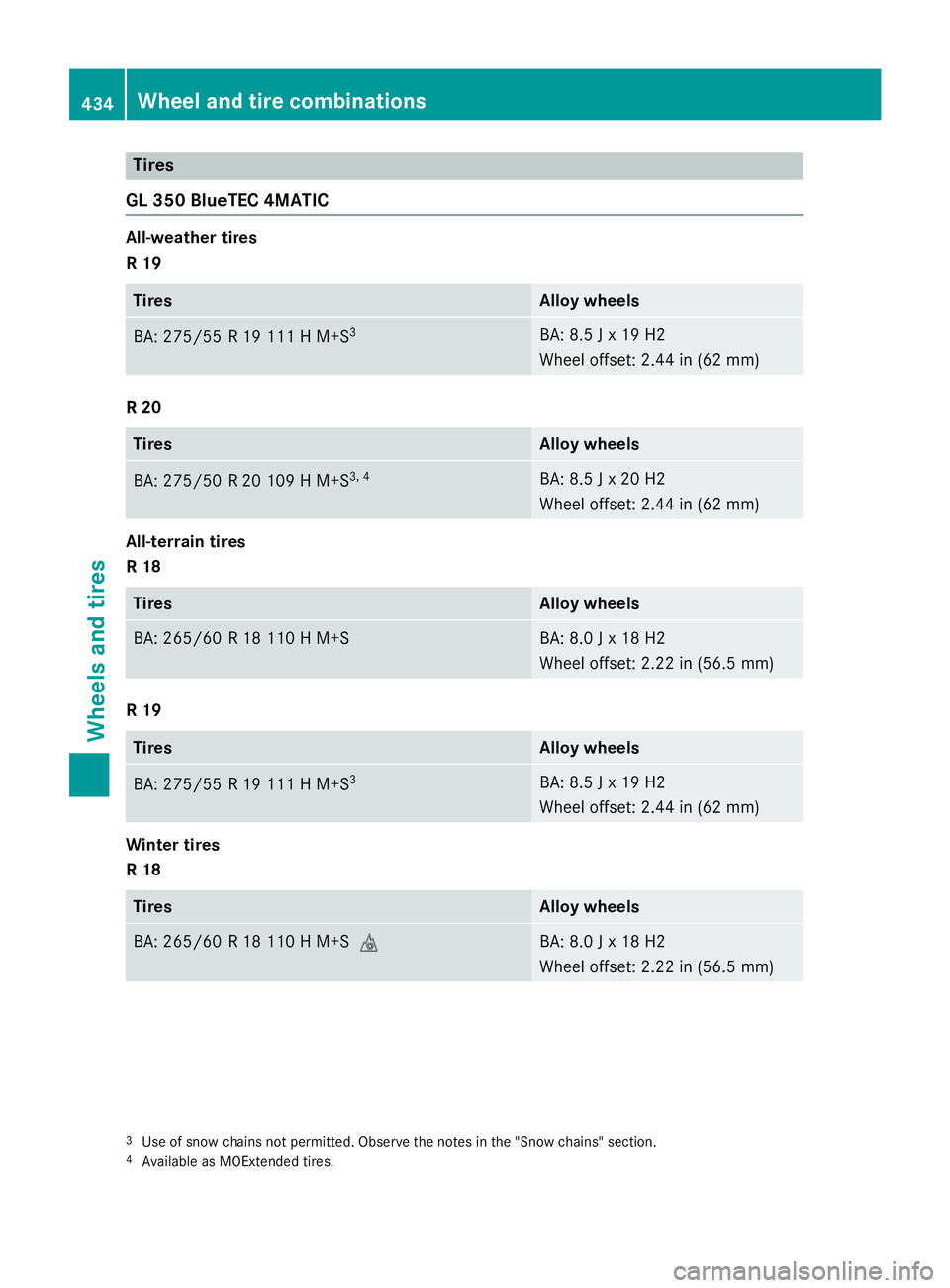
Tires
GL 350 BlueTEC 4MATIC All-weather tires
R 19
Tires Alloy wheels
BA: 275/55 R 19 11 1 H M+S 3
BA: 8.5 J x 19 H2
Wheel offset: 2.44 in (62 mm)
R 20
Tires Alloy wheels
BA: 275/50 R 20 109 H M+S 3, 4
BA: 8.5 J x 20 H2
Wheel offset: 2.44 in (62 mm)
All-terrain tires
R 18
Tires Alloy wheels
BA: 265/60 R 18 110 H M+S BA: 8.0 J x 18 H2
Wheel offset: 2.22 in (56.5 mm)
R 19
Tires Alloy wheels
BA: 275/55 R 19 111 H M+S 3
BA: 8.5 J x 19 H2
Wheel offset: 2.44 in (62 mm)
Winter tires
R 18
Tires Alloy wheels
BA: 265/60 R 18 110 H M+S �M BA: 8.0 J x 18 H2
Wheel offset: 2.22 in (56.5 mm)
3
Use of snow chains not permitted. Observe the notes in the "Snow chains" section. 4
Available as MOExtended tires.434
Wheel and tire combinations
Wheels and tires